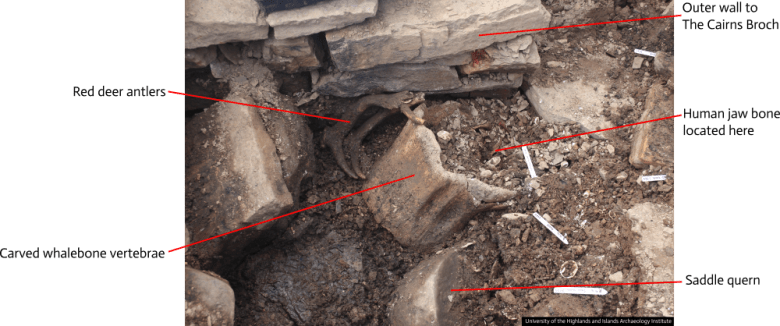
Placing the ‘Elder assemblage’ in its contemporary context and setting
Well, today was our open day and we welcomed many folks to site to witness both the archaeological remains and the process of excavation.

Although the weather, for most of the day, was much better than suggested by the forecast, there was a little rain here and there and I’d like to thank all the visitors and guests for coming out to see us and our work.
As is usual on an open day there’s perhaps not as much excavation work as is possible as on an ordinary day at site. Nevertheless, good progress was made on several fronts and here’s a short summary…
In Structure O, excavation gave way to recording but to the south-west, next to Structure E, Katie and Zoe teamed up to work on the animal skull with the cut horns and they were able to expose much more of the bone.
Hopefully, we’ll very soon be able to lift it, intact, from the ground.

In the broch, good progress was made in the South-east Room to excavate the fan of dark rake-out on the western side of the hearth and it was possible to lift the whalebone epiphysis and inspect it.
It is, indeed, an unfused vertebral disc, which comes from a juvenile/adolescent animal.
Elsewhere in the broch, a fantastic complete “knocking stone” was excavated from the Central Room. This is a mortar-like stone that would have been used to pound and pulp substances.

Readers may well remember that one of our key aims for the season was to learn more about the context of the remarkable “Elder Assemblage“, previously discovered at the broch frontage zone. This comprised the human jawbone/whalebone vessel deposit that had been made outside the broch at the closure of the broch around AD200.
Today, Holly, Chloe, and Anna, have really managed to crystallise this sense of the context of that deposit in exciting ways.

Just to remind readers, when we first discovered and excavated the Elder assemblage, in 2016, the big whalebone vessel was found to be next to a little wall that rested directly against the broch wall. The work undertaken by Holly’s team has now exposed this wall more fully and the feature has a small niche “cupboard”, with a neat lintel over the top.
Furthermore, a masonry block at the left-hand side of the niche is, in fact, very clearly a nice and substantial saddle-quern set on its edge in a highly visible manner.

This niche-wall is not unlike a simplified version of the “dressers” found in earlier Neolithic houses. So, it was against this distinctive niche wall that the big whalebone vessel and the “Elder” jawbone had been placed, pinned into place using a massive saddle quern, when the broch was decommissioned.

Meanwhile, the thick shell and animal bone midden in the broch frontage can now be clearly seen as part of this overall closing deposit, both capping and accompanying the Elder assemblage.
The entire set of “feasting” remains relates to this deposit and seems to be yet another part of the acts that marked the end of the broch.




Below the midden deposit, a surface of orangey clay with masses of charcoal has emerged.
This clearly relates to the structure/building that can now be seen to sit outside the broch, and which uses the outer wall of Structure O. We are calling this Structure T.
Like Structure O, it must be another Middle Iron Age, broch-period, building – or yard – and this is very good news for our research aims. It will ultimately help us further understand the layout of the village during the broch era.
As well as the clay surface, the team found a substantial flagstone next to a large, edge-set sill-stone, just at the foot of the niche wall. These may well be part of a surface approaching the front of the niche wall, but may also relate to a possible entrance in Structure T. Time will tell.

For now, though, we’re very pleased to be able to place the Elder assemblage, such an important act of remarkable deposition, in its contemporary context and setting.
Placed at the foot of the discrete stone niche-wall, a fascinating feature in its own right, with its reference to the past inherent in the re-used quern, the assemblage was also accompanied by the deposition of thousands of shells and other food remains.
Taken together, all of this enlarges our sense of the end of broch event and brings it into sharper focus.
Martin Carruthers
Site Director


